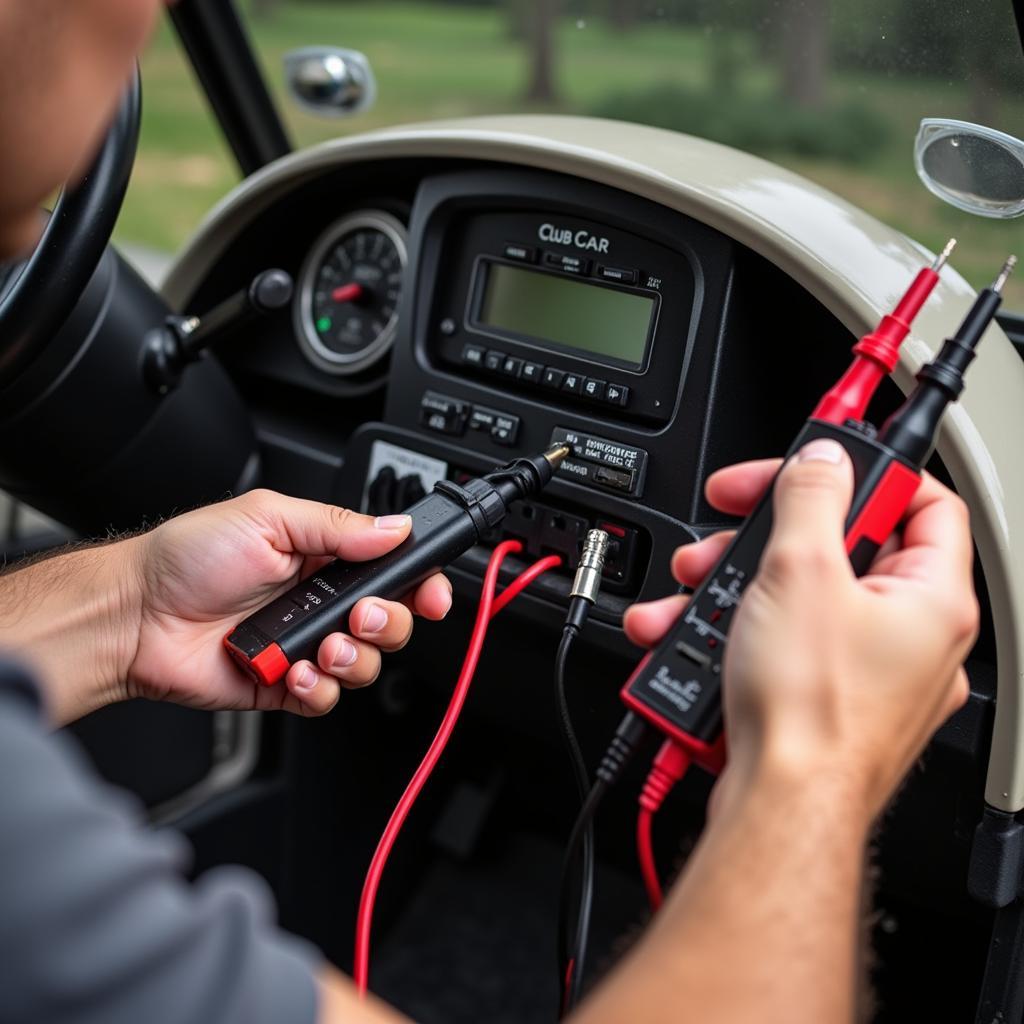Experiencing a throttle problem with your Club Car Turf 2 golf cart can be a frustrating experience. Whether your cart is hesitating, surging, or simply refusing to move, a malfunctioning throttle system can bring your ride to a standstill. This comprehensive guide is designed to help you diagnose and potentially fix the issue, getting you back on the course in no time.
Understanding Your Club Car Turf 2 Throttle System
Before diving into troubleshooting, it’s helpful to have a basic understanding of how your Club Car Turf 2’s throttle system works. These carts typically employ an electronic throttle control system, a sophisticated setup that relies on several key components:
- Accelerator Pedal: Pressing the pedal sends a signal to the controller, indicating the desired speed.
- Throttle Position Sensor (TPS): This sensor measures the position of the accelerator pedal and translates it into an electrical signal for the controller.
- Controller: The brain of the system, the controller receives signals from the TPS and other sensors to regulate the amount of power sent to the motor.
- Motor: The motor receives power from the controller and propels the golf cart forward.
Problems with any of these components can lead to throttle issues.
Common Club Car Turf 2 Throttle Problems and Solutions
Let’s explore some of the most common throttle-related issues you might encounter with your Club Car Turf 2 and provide a step-by-step approach to diagnosing and potentially fixing them.
1. Cart Won’t Move or Has Limited Power
Possible Causes:
- Faulty Accelerator Pedal: The accelerator pedal might be worn out, damaged, or its connection to the TPS could be loose.
- Malfunctioning TPS: A faulty TPS won’t send the correct signal to the controller, leading to power delivery issues.
- Controller Problems: The controller itself could be faulty, failing to interpret signals correctly or regulate motor power.
- Blown Fuse: A blown fuse in the throttle system circuit can interrupt power flow.
Troubleshooting Steps:
- Check the Fuse: Locate the fuse box (refer to your owner’s manual) and inspect the fuse associated with the throttle system. Replace it if blown.
- Inspect the Accelerator Pedal: Visually inspect the accelerator pedal for any visible damage. Ensure it moves freely and its connection to the TPS is secure.
- Test the TPS: Use a multimeter to test the TPS for correct voltage output as you depress the accelerator pedal. Refer to your service manual for specific voltage values.
- Inspect the Controller: Visually check the controller for any signs of damage, such as burnt components or loose connections. If you suspect a controller issue, it’s best to consult a qualified technician.
 Inspecting the Controller
Inspecting the Controller
2. Cart Hesitates or Surges
Possible Causes:
- Dirty or Faulty TPS: A buildup of dirt or debris on the TPS can disrupt its signal, causing hesitation or surging.
- Loose or Corroded Connections: Loose or corroded connections within the throttle system, particularly at the TPS or controller, can cause intermittent signal disruptions.
- Failing MCOR: Some older Club Car Turf 2 models use a Motor Control Output Regulator (MCOR) instead of a traditional TPS. A failing MCOR can exhibit similar symptoms.
Troubleshooting Steps:
- Clean the TPS: Carefully remove the TPS and clean any dirt or debris from the sensor and its contact points using electrical contact cleaner.
- Inspect and Clean Connections: Check all connections within the throttle system, including those at the TPS, controller, and accelerator pedal. Clean any corroded connections using a wire brush and apply dielectric grease to prevent future corrosion.
- Test the MCOR (if applicable): If your cart has an MCOR, test its resistance using a multimeter. Refer to your service manual for specific resistance values. Replacement is often the best course of action for a failing MCOR.
 Cleaning the Throttle Position Sensor
Cleaning the Throttle Position Sensor
3. Throttle Pedal is Stiff or Difficult to Depress
Possible Causes:
- Binding Accelerator Cable: The accelerator cable connecting the pedal to the throttle mechanism might be binding or sticking.
- Worn or Damaged Pedal Assembly: The accelerator pedal assembly itself could be worn out or damaged, making it difficult to depress.
Troubleshooting Steps:
- Lubricate the Accelerator Cable: Apply a silicone-based lubricant to the accelerator cable to reduce friction and ensure smooth operation.
- Inspect the Pedal Assembly: Carefully examine the accelerator pedal assembly for any signs of wear, damage, or obstructions. Replace any damaged or worn components.
 Lubricating the Accelerator Cable
Lubricating the Accelerator Cable
When to Seek Professional Help
While this guide provides a starting point for troubleshooting, some Club Car Turf 2 Throttle Problems may require the expertise of a qualified golf cart technician, especially if:
- You are not comfortable working with electrical components.
- The problem persists after attempting the troubleshooting steps outlined above.
- You suspect a complex issue with the controller or other electronic components.
Attempting to repair complex electrical systems without proper knowledge and tools can be dangerous and potentially cause further damage.
Conclusion
Addressing throttle problems with your Club Car Turf 2 can save you time, money, and frustration in the long run. By understanding the common causes and following the troubleshooting steps in this guide, you can often identify and resolve these issues yourself. However, always prioritize safety and seek professional help if you encounter any challenges or are unsure about any aspect of the repair process.
Need expert assistance with your Club Car Turf 2 throttle problem? Contact AutoTipPro today at +1 (641) 206-8880 or visit our office at 500 N St Mary’s St, San Antonio, TX 78205, United States. Our team of experienced technicians is standing by to get you back on track.







Leave a Reply